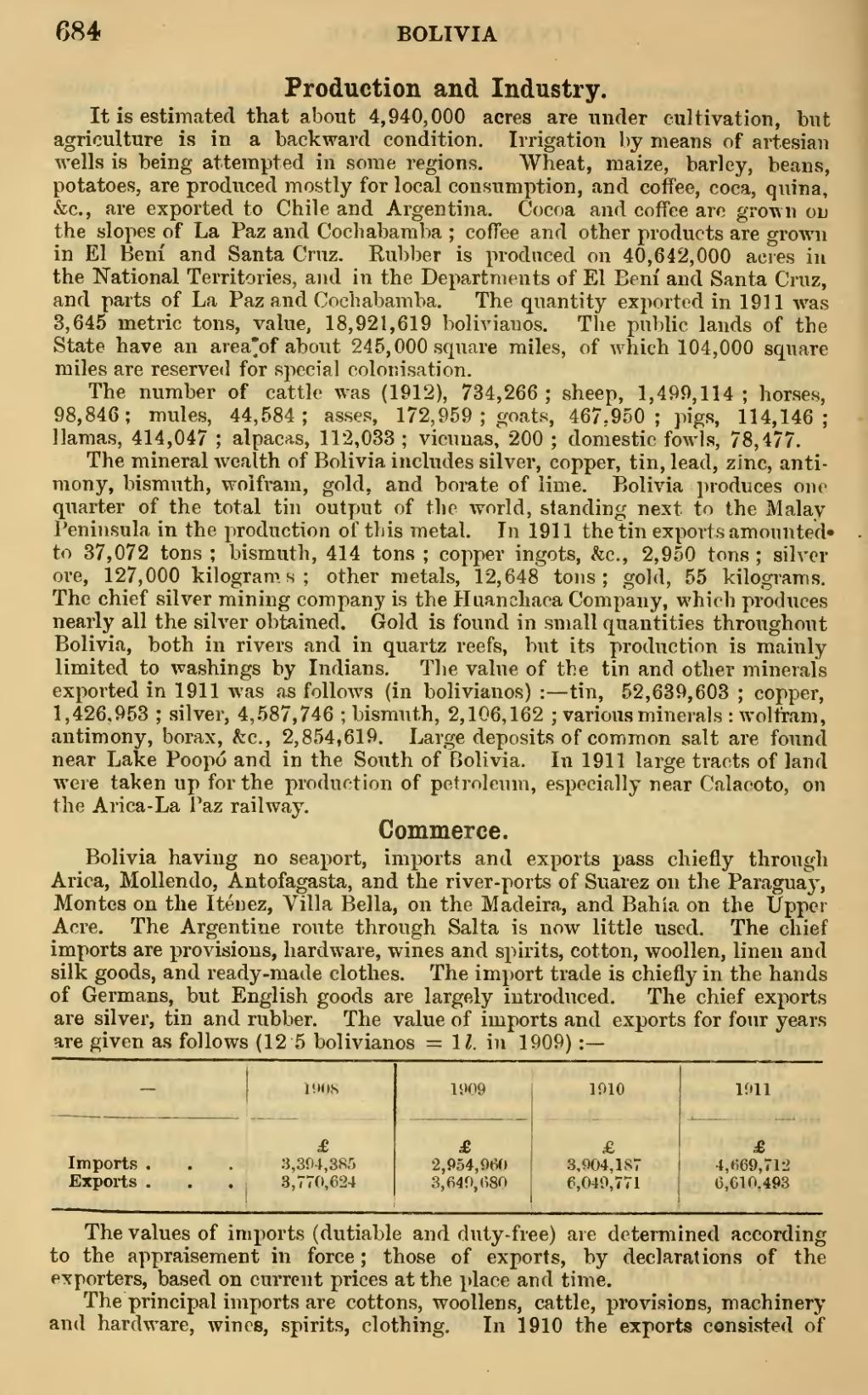684
BOLIVIA
Production and Industry.
It is estimated that about 4,940,000 acres are under cultivation, but agriculture is in a backward condition. Irrigation by means of artesian wells is being attempted in some regions. Wheat, maize, barley, beans, potatoes, are produced mostly for local consumption, and coffee, coca, quina, &c., are exported to Chile and Argentina. Cocoa and coffee are grown on the slopes of La Paz and Cochabamba ; coffee and other products are groAvn in El Beni and Santa Cruz. Rubber is produced on 40,642,000 acres in the National Territories, and in the Departments of El Beni and Santa Cruz, and parts of La Paz and Cochabamba. The quantity exported in 1911 Avas 3,645 metric tons, value, 18,921,619 bolivianos. The public lands of the State have an area'of about 245,000 square miles, of which 104,000 square miles are reserved for special colonisation.
The number of cattle was (1912), 734,266 ; sheep, 1,499,114 ; horses, 98,846; mules, 44,584; asses, 172,959 ; goats, 467,950; pigs, 114,146; llamas, 414,047 ; alpacas, 112,033 ; vicunas, 200 ; domestic fowls, 78,477.
The mineral wealth of Bolivia includes silver, copper, tin, lead, zinc, anti- mony, bismuth, wolfram, gold, and borate of lime. Bolivia produces one quarter of the total tin output of the world, standing next to the Malay Peninsula in the production of this metal. In 1911 the tin exports amounted* to 37,072 tons ; bismuth, 414 tons ; copper ingots, kc, 2,950 tons ; silver ore, 127,000 kilograms; other metals, 12,648 tons; gold, 55 kilograms. The chief silver mining company is the Huanchaca Company, which produces nearly all the silver obtained. Gold is found in small quantities throughout Bolivia, both in rivers and in quartz reefs, but its production is mainly limited to washings by Indians. The value of the tin and other minerals exported in 1911 was as follows (in bolivianos) : — tin, 52,639,603 ; copper, 1,426,953 ; silver, 4,587,746 ; bismuth, 2,106,162 ; various minerals : wolfram, antimony, borax, &c., 2,854,619. Large deposits of common salt are found near Lake Poopo and in the South of Bolivia. In 1911 large tracts of land were taken up for the production of petroleum, especially near Calacoto, on the Arica-La Paz railway.
Commerce.
Bolivia having no seaport, imports and exports pass chiefly through Arica, Mollendo, Antofagasta, and the river-ports of Suarez on the Paragua}-, Montes on the Itenez, Villa Bella, on the Madeira, and Bahia on the Upper Acre. The Argentine route through Salta is now little used. The chief imports are provisions, hardware, wines and spirits, cotton, woollen, linen and silk goods, and ready-made clothes. The import trade is chiefly in the hands of Germans, but English goods are largely introduced. The chief exports are silver, tin and rubber. The value of imports and exports for four years are given as follows (12 5 bolivianos = 11. in 1909) :—
-
100)5
1909
1010
1011
Imports . Exports .
£
3,304, 3S5 3,770,624
—
£
2,954,960 3,640,680
— -
£ .3,904,187 6,049,771
£
4,669,712 6,010,493
The values of imports (dutiable and duty-free) are determined according to the appraisement in force ; those of exports, by declarations of the exporters, based on current prices at the place and time.
The principal imports are cottons, woollens, cattle, provisions, machinery and hardware, wines, spirits, clothing. In 1910 the exports consisted of
